|
|
{BANNER_STUFF}
Features of KwaZulu-Natal 
KZN North Coast courtesy of John Lamberti
Republic of South Africa
The Republic of South Africa lies at the southern end of the African continent. It is bounded by the Indian Ocean to the east and the Atlantic Ocean to the west, and is bordered to the north by Namibia, Botswana, Zimbabwe, Mozambique and Swaziland and totally encloses Lesotho.
KwaZulu-Natal
Following the 1994 elections, South Africa was organized into nine provinces: the Eastern Cape, Western Cape, Northern Cape, KwaZulu-Natal, Free State, North West Province, Northern Province, Mpumalanga and Gauteng.
KwaZulu-Natal is located on the Indian Ocean seaboard, occupying 92,100 m2, almost 8%, of the total land area of South Africa. The Province stretches from Port Edward in the south to the Swaziland and Mozambique borders to the north. KwaZulu-Natal is established around two of Africa's gateways to the sea-lanes of the world- Durban and Richards Bay. Pietermaritzburg is the capital.
Traditionally, a popular destination for holiday-makers from other South African provinces, KwaZulu-Natal offers sunny weather, beaches, game parks, rolling green hills and majestic mountains.
Topography 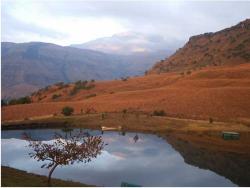
Drakensberg
Vegetation 
Sunset in the Bush
Due to its abundant varied vegetation, KwaZulu-Natal is often described as the Green Province. With more than 11 000 plant species, the Province is one of the richest floral regions in Africa. The 780 tree species comprise more than two-thirds of South Africa's total - and 11 times the total of Europe. Approximately 16% of the flora is endemic and 11% is rare or threatened.
Natural vegetation, where it has not been modified or destroyed, falls into several belts according to altitude and climate. Along the coast forests, mangrove swamps, indigenous bush and some of the highest forested coastal dunes in the world are present. A profusion of Lala and wild banana palms grow along the south coast; while sugarcane covered fields predominate in the north. Dry sand-forest and bushveld or savannah, studded with fever trees and umbrella thorns characterizes the Zululand region. While south, in the river basins and valleys, cactus like euphorbias (spurges) are common.
The Midlands and southwest region sustains lakes, wetlands, grasslands, and mist-belt forests. The montane species are found on the slopes of the Drakensberg.
The warm Mozambique current brings a subtropical climate, which prevails for most of the year at the coast. The summers are hot and humid with temperatures reaching 32° to 35° centigrade. Many towns lie in a mist belt in the Midlands region. Winters are warm and dry; temperatures seldom drop lower than 12° or 14° centigrade. However in winter, snow and ice can cover the mountaintops and sometimes the high lying land. KwaZulu-Natal receives the highest rainfall in the country, which falls mostly in summer (Dec to Feb).
Daylight
Sunshine is plentiful, varying from 7.5 to 9.5 hours daily. Winter sunshine averages almost seven hours a day.
Time Difference
Throughout the year, Standard Time in South Africa is two hours ahead of Greenwich Mean Time, one hour ahead of Central European Time and seven hours in advance of Eastern Standard Time in the United States.
Population
KwaZulu-Natal, the third smallest province in South Africa, is home to 21% of the country's population (approximately 9.4 million in the 2001 census).
There are diverse ethnic groups, consisting of the Zulu nation (the prominent African tribe), with a White population including a majority of people of English descent, a substantial number of Afrikaans-speaking people, and a significant portion of Indian people. Whites currently constitute 5,1%, Asians 8,5%, Blacks 84,9 % and Coloureds 1,5 %. Females make up 53, 22% of the population and males 46, 78%. Durban has the biggest concentration of Indian people outside of India.
Towns And Places 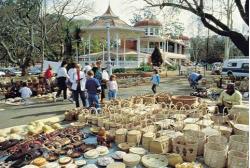
Craft for sale in Pietermaritzburg (courtesy of SA Tourism)
Petermaritzburg
The city of Pietermaritzburg is a thriving, modern legislative and administrative capital, which is growing as an economic centre. http://www.msunduzi.gov.za/
Known as the City of Flowers, Pietermaritzburg is renowned for its Botanic gardens, one of only eight in the country and other parks such as Wylie Park, Alexandra Park and the headquarters of KZN Wildlife - Queen Elizabeth Park. The city plays host to spectacular sports events, annual outdoor festivals and an annual agricultural show which is without parallel on Africa’s east coast. The Tatham Art Gallery is today one of the country’s top seven art museums. http://www.tatham.org.za/
‘Butterflies for Africa’ is a prime attraction. The butterfly house enables visitors are able to come into close contact with butterflies from around the world as they fly freely in an attractive, lush environment.
Durban 
Durban Panoramic (Courtesy of the ICC)
Cosmopolitan Durban’s harbour is central to the city being described as the economic hub of KwaZulu-Natal. The city provides a variety of attractions from busy shopping malls, to sunny beaches and beautiful gardens. The influences of Asian, Zulu, English Colonial and Afrikaans cultures are apparent in the variety of architectural styles present in the churches, offices, skyscrapers and homes. Durban is considered to have one of the best selections of Art Deco architecture of any city in the world. The Juma Musjid Mosque and its gilt-domed minarets (1927) is the largest mosque in the southern hemisphere. In Chatsworth, the Temple of Understanding is South Africa’s most spectacular Hindu temple.
Apart from impressive buildings in the city centre, Durban’s multi-million rand International Convention Centre and adjoining luxury Hilton Hotel complex is the focal point of a growing conference and business tourism industry. The nearby Durban Exhibition Centre adds even greater possibilities to these facilities.
Some gardens attractions include Mitchell Park and opposite to it, Jameson Park with its glorious rose garden. Durban Botanic Gardens, offers an herb garden, orchid house, a world famous cycad collection and a garden for the blind. Makaranga Garden Lodge and hotel, 25km from Durban in Kloof, is set amongst 30 acres of spectacular botanical gardens. The gardens are comprised of magnificent Makaranga trees, Camellias, Rhododendrons, Magnolias, a variety of Orchids, as well as indigenous plant life. An authentic Japanese Garden in Durban North gives a different perspective on garden viewing.
Wilder options close to the city include: Durban’s Burman Bush, which offers three trails and facilities such as braai and picnic sites; Hawaan Forest, Kloof Gorge and Yellowwood Park Nature Reserve.
uShaka Marine World 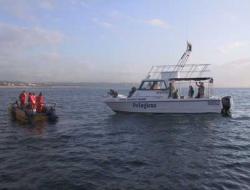
KZN Sharksboard at work (courtesy of the Sharks Board)
Wilson’s Wharf
Wilson’s Wharf is a waterfront development with eateries, galleries, theatres and a huge craft market. Harbour and deep sea boat trips depart from Wilson’s Wharf and allow visitors get a special view of Durban and the harbour at work or go out to sea to view dolphins and whales.http://www.wilsonswharf.co.za/
The Natal Sharks Board research facility in Umhlanga offers a 20-minute movie showcasing sharks, followed by a shark dissection and has displays of newspaper articles covering shark attacks over the years. http://www.shark.co.za/
Other places of interest in Durban are the Umgeni Bird Park and a Mini- town.
www.umgeniriverbirdpark.co.za/

Valley of a Thousand Hills (Courtesy of SA Tourism)
Township visits
Township visits to Inanda and Umlazi offers a chance to experience the life of the people of KwaZulu-Natal and a glimpse of their future aspirations. The Inanda Heritage Route - includes the Ohlange Institute, Phoenix settlement of Ghandi, Inanda Seminary and Ebuhleni, place of the Shembe church. Umlazi is KwaZulu-Natal's largest township and the second largest in South Africa after Soweto. (www.umlazi.co.za)
Cato Manor is an urban development node near the city centre with a unique story of forced removals and development under a Presidential Lead Project.
The Valley of a Thousand Hills
The Valley of a Thousand Hills is the steeply dissected regions of hills and watercourses lying west of the city of Durban. The Thousand Hills Tourism Route starts at Fields Hill outside Pinetown, which is one of the main areas of economic activity in KwaZulu-Natal.
The tourist route then continues parallel to the old railway through Kloof, Everton, Gillitts and Hillcrest, which are rapidly growing residential areas. This road was built by captives rescued from a slave ship. Further south is the Shongweni area, with its economy of racing, horse farming, polo and tourism. There are plenty of craft markets, restaurants, curio shops, Zulu villages and safari parks. Close to the route is the lovely Shongweni Dam. http://1000hills.kzn.org.za/
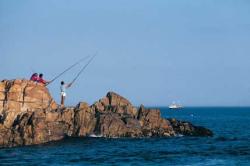
KZN South Coast Fishing (Courtesy of SA Tourism)
Upper South Coast
The upper south coast road passes through Amanzimtoti, Umkomaas and Scottburgh. Amanzimtoti is a new growth area with a wide range of residential and shopping complexes presently being constructed. Umkomaas is a divers Mecca. Dive operators are available to take divers to the world- famous Aliwal Shoal and further afield. Scottburgh is one of the most popular south coast resorts; attractions here include a Crocworld, snake tunnel, bunny park, and a bird park. A number of golf courses are present including Selbourne and Umdoni.
Hibiscus Coast
The coastline from Hibberdene to Port Edward is called the Hibiscus Coast. Port Shepstone and Margate are the largest towns on the south coast. Resort towns include Mzumbe, St Michaels on Sea, Sunwich Port, Bendigo, Southport and Umtentweni. Port Shepstone is currently the focus of numerous proposed development plans that include an inner harbour, canal, pier and coastal boardwalk. The development will reinforce the area as a premier tourist destination with the potential for excellent property value growth over the next few years. Plans for a water- type development are also proposed for Hibberdene. The area is known for its great beaches, surfing spots and golfing opportunities. One of KwaZulu-Natal's most spectacular natural settings, the scenic Oribi Gorge Nature Reserve lies some 21 km inland from Port Shepstone.
http://hibiscuscoast.kzn.org.za/
The Dolphin Coast 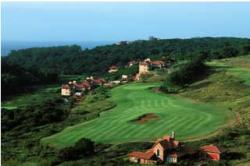
Golf Course at Zimbali Coastal Resort
The Dolphin Coast stretches from Umhlanga Rocks, a thriving, vibrant and upmarket beach resort area, north of Durban, to the mouth of the Tugela River. The Umhlanga Ridge New Town Centre is a dynamic business environment, surrounded by some of the premium residential developments in South Africa. These include Durban North, La Lucia, Somerset Park and Broadlands, as well as the prestigious golf estates of Mount Edgecombe and Zimbali. Developments completed in the area comprise of the Gateway Shopping Centre, Umhlanga Hospital and Medical Centre, offices of many of Durban's blue chip and multinational companies, motor dealerships, residential development, health clubs, private schools and places of worship.
http://dolphincoast.kzn.org.za/
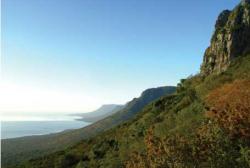
Royal Jozini (Courtesy of the eLan Group)
Richards Bay
The progressive town of Richards Bay lays claim to one of the country's largest harbours. Due to rapid industrial expansion the thriving business centre has every modern facility. The excellent recreational facilities ensure that the town is fast becoming the favoured north coast holiday destination, as well as the gateway to the Zululand and Maputaland tourist region.
Zulu Heartland 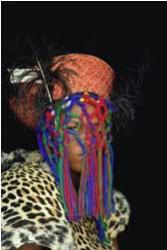
Young Zulu Bride (courtesy of SA Tourism)
KwaZulu-Natal is referred to as the Kingdom of the Zulus. Zululand boasts a wide range of markets, craft shops and galleries, where one can purchase the finest Zulu crafts. Traditional baskets, woven beer strainers, Zulu drums, shields and assegais, beadwork, pottery and regalia. Shaka Land provides the opportunity to learn more about the local customs from tribal dancing to traditional beer-drinking ceremonies.
Eshowe is the former administrative capital of Zululand. Here, Fort Nonqayi bears witness to the events after the Anglo-Zulu War of 1869. The aerial boardwalk in the Dlinza forest is a delight- and offers excellent birding opportunities. The Vukani Collection Museum boasts one of the best collections of Zulu art and culture in the world.
The Province contains a number of small towns and villages that are rich with African and European culture and history. Many interesting sites have a colourful history of heroic people, struggles and wars.
Heritage Sites The Province lays claim to two World Heritage Sites; the iSimangaliso Wetland Park (formerly the Greater St Lucia Wetland Park) and the Ukhahlamba Drakensberg Park.
Simangaliso Wetland Park
Declared as one of South Africa’s first World Heritage Sites in 1999, the iSimangaliso Wetland Park Wetlands Park, extends across 332 000 hectares of awe-inspiring scenery, from Mapelane (Cape St Lucia) in the South to Kozi Bay in the North. The 220 km coastline enjoys the highest conservation status in the country. Isimangaliso also forms a significant part of the Lubombo Transfrontier Conservation Area.
The Park contains eight interlinking eco-systems including beautiful lakes, forests, 25 000 year old coastal dunes and marshlands. Some of South Africa’s best-protected indigenous coastal forests are found here at Dukuduku and Kosi Bay. Amongst other animals, the Park is home to large populations of rhino, hippo and crocodiles. The Park also has 526 bird species, 36 species of snakes, 35 species of frogs, 80 species of dragon flies and 110 species of butterflies. The coastal waters have abundant plant and sea-life, including the humpback whale and loggerhead turtle. The range of activities available includes bird-watching; fishing; hiking; camping and scuba-diving. All of which offer fantastic photographic opportunities.
In the vicinity, Sodwana is a mecca for those who desire underwater adventure and big-game fishing. iSimangaliso Wetland Park made modern natural history when living fossils - coelacanths - were discovered off its warm Indian Ocean shoreline. In addition, coral reefs offer underwater visual treasures to snorkellers and scuba divers.
Significant cultural heritage sites include evidence of Stone Age human activity, fish traps dating back 700 years at Kosi Bay and five distinct cultural groups.
www.isimangaliso.co.za/
Mountains
The Drakensberg or Dragon Mountains, also known as the Barrier of Spears, is the highest mountain range in South Africa. The 243 000 hectare Ukhahlamba-Drakensberg Park was declared a World Heritage Site in 2000. The area’s unique richness of biological diversity includes both endemic and endangered species and many remarkable San rock paintings. The Ukhahlamba Drakensberg mountain range runs along the entire length of the border between KwaZulu-Natal and the Kingdom of Lesotho. The main road access is via the Sani Pass. Located at the top, some 3000m above sea level, is Africa’s highest pub and lodge. Champagne Castle is the home of the Drakensberg Boys Choir - a world- renowned boy’s choir. The school regularly offers mid- week concerts that add an unforgettable highlight to a tour through the area. The Drakensberg is particularly beautiful in winter when snow covers the craggy mountain peaks.
On Safari
KwaZulu-Natal offers a large number of wildlife experiences. Hluhluwe-Umfolozi Park is the largest of KwaZulu-Natal’s reserves. It is famous for its rhino conservation programme and big five sightings as well as a range of birds and other wildlife. Mkuzi and Ndomo game reserves are also popular and walking trips in these reserves unforgettable. Overlooking the Pongola River valley in Northern KwaZulu-Natal, Ithala Game reserve offers an extraordinary experience. The Reserve’s range of habitats is home to an impressive array of wildlife. Ithala’s most characteristic feature is its geological diversity. The rock formations found here date back 3 000 million years. A number of smaller private reserves such as Phinda and White Elephant lodge offer unforgettable bush experiences. Close to Durban and Pietermaritzburg, Tala Private Game Reserve is a conservancy within easy reach of a worthwhile visit. http://zululand.kzn.org.za/zululand/
The Battlefields
Boers, Zulus, British, Shaka, Isandlwana, Rorkes Drift, Colenso, Spioenkop, Ladysmith, Dundee, Churchill, Blood River, Cetshwayo are all associated with this internationally renowned area of KwaZulu-Natal. The legacy of the Zulu kingdoms conflicts live on in a series of battlefield sites, monuments, museums and towns making it a must for history enthusiasts. The region also offers beautiful scenery and a mix of culture. Current plans to develop the sites as tourist attractions include the construction of the world’s sixth Panorama near Isandlwana, which will continue to make the past live on.
http://battlefields.kzn.org.za/battlefields/
|